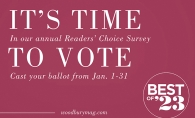2017 is a big year for Woodbury. Big, in that it’s celebrating its 50th anniversary in March, and it has a whole year of festivities planned to mark the occasion.
While the first settlers (mostly from eastern states and Germany) came to the area in the 1840s, back when it was called Red Rock, it wasn't until 1967 that Woodbury incorporated. However, it was even earlier that development in the area began, says Dwight Picha, community development director and 40-year employee of the city.
“The actual development of the city of Woodbury started in the mid-1950s, with the development of the first residential area which is still called Woodbury Heights,” Picha says. From there, a booming business called 3M drew residents to the growing east side city. “There were several developments that occurred in the ‘60s, and there were quite a few 3Mers moving into the new subdivisions.”
That’s around the time when the town board and other citizens came together and thought it might be a good idea to incorporate. Highways like I-494 and Old Hwy. 12 (now I-94) were being planned, the freeway system was beginning to connect the Twin Cities, “and the sewer system was being brought out from St. Paul into Maplewood and up to our border,” Picha says. “So the city leaders really thought that it would be a wise choice to become a city, which gives the city more control—fiscal ability to regulate what was going on.”
Bob Klatt, parks and recreation director and 33-year employee of the city, adds that it wasn’t just the top men on the board making this decision: “The Jaycees group was a pretty active group in those early times that was made up of citizens.” So the Jaycees, along with the board, “decided to take it to the voters to see if they wanted to become a city,” Picha says, and it passed.
From there, the city growth just kept coming. The population estimate went from 6,184 in 1970, to 10,297 in ’80, to 20,075 in ’90, and then jumped to 46,463 by the year 2000. That growth meant a lot of change was needed. “I would say the school district was one of the big changes,” Picha says. While the city now is in three different school districts, “Woodbury did not have a high school until 1975.”
At the same time as Woodbury High School was built, the city initiated a parks referendum to buy the land next to the new school, which is now Ojibway Park. That referendum allowed for more parks throughout the city as it developed. “I think the Park Hills neighborhood, and that development, kind of set the stage for park development,” Klatt says.
The parks, schools and everything kept growing, leading to today, with a population of 68,725 estimated in 2016. So there’s a lot to celebrate in Woodbury’s 50th year. “I think we’ll try to incorporate the 50th anniversary in just about everything we do [this year],” says Jason Egerstrom, the city’s communications coordinator; it started with December's tree lighting ceremony at Bielenberg’s outdoor rink.
As to what the year’s celebrations will be, “We’re really focusing on the existing annual recurring events,” says Sarah Alig, assistant to the city administrator and project lead. “The four that we’ll be particularly focusing on are the state of the city in February, the anniversary celebration in March, the community expo on April 1, and then Woodbury Days." So prepare for a few parties, and happy birthday, Woodbury.
State of the City
1 p.m. February 26, Central Park
Address by Mayor Mary Giuliani Stephens followed by music and light refreshments.
Anniversary Celebration
For more details as the event dates near, visit the city website here. You’ll also find more information on the history of the city.









